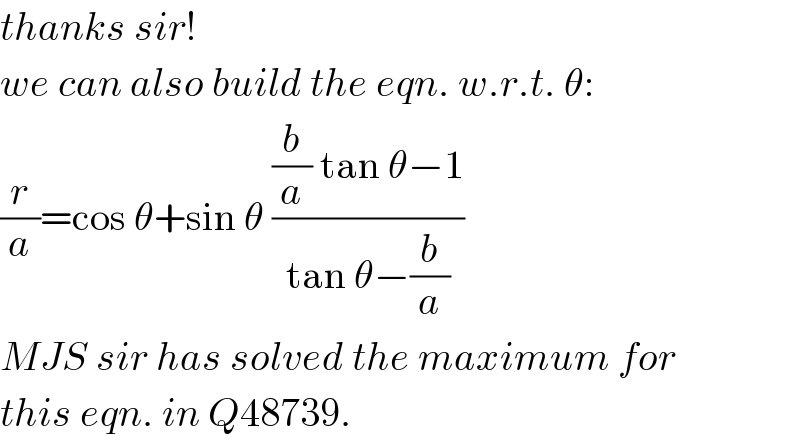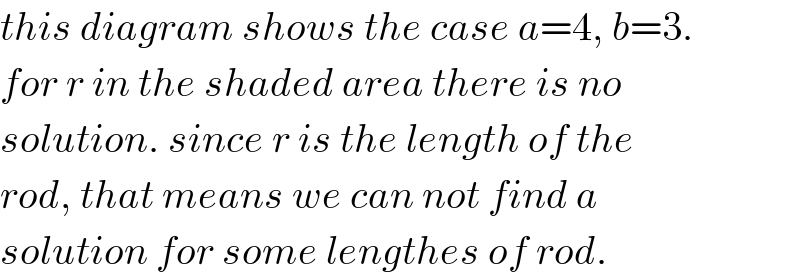
Question and Answers Forum
Question Number 48638 by mr W last updated on 26/Nov/18

Commented by mr W last updated on 26/Nov/18

Commented by ajfour last updated on 28/Nov/18

Commented by ajfour last updated on 28/Nov/18
![(a/(sin φ)) = (r/(sin (θ+φ))) & (b/(sin φ)) = (r/(sin ((π/2)−θ+φ))) = (r/(cos (θ−φ))) ⇒ sin θcos φ+cos θsin φ=(r/a)sin φ sin θsin φ+cos θcos φ+=(r/b)sin φ ⇒ sin θ = ((rsin φ(((cos φ)/a)−((sin φ)/b)))/(cos^2 φ−sin^2 φ)) cos θ = ((rsin φ(((cos φ)/b)−((sin φ)/a)))/(cos^2 φ−sin^2 φ)) ⇒ 1=((r^2 sin^2 φ[(((cos φ)/a)−((sin φ)/b))^2 +(((cos φ)/b)−((sin φ)/a))^2 ])/((cos^2 φ−sin^2 φ)^2 )) ⇒ 1=((r^2 sin^2 φ[(1/a^2 )+(1/b^2 )−((4sin φcos φ)/(ab))])/((cos^2 φ−sin^2 φ)^2 )) ⇒ r^2 = ((cos^2 2φ)/(sin^2 φ((1/a^2 )+(1/b^2 )−((2sin 2φ)/(ab))))) r^2 = ((cot^2 φ−1)/((1/a^2 )+(1/b^2 )−((2sin 2φ)/(ab)))) ((2rdr)/dφ) = 0 ⇒ −2cot φcosec^2 φ((1/a^2 )+(1/b^2 )−((2sin 2φ)/(ab))) = ((−4cos 2φ)/(ab))(cot^2 φ−1) ⇒ ((a^2 +b^2 )/(2ab))−sin 2φ = cos^2 2φtan φ let tan φ = t , ((a^2 +b^2 )/(2ab)) = c ⇒ t(((1−t^2 )/(1+t^2 )))^2 +((2t)/(1+t^2 ))−c = 0 ⇒ t(1−t^2 )^2 +2t(1+t^2 )−c(1+t^2 )^2 = 0 .....](Q48776.png)
Commented by mr W last updated on 28/Nov/18

Answered by ajfour last updated on 26/Nov/18

Commented by ajfour last updated on 26/Nov/18

Commented by mr W last updated on 26/Nov/18

Commented by ajfour last updated on 26/Nov/18

Commented by mr W last updated on 26/Nov/18

Commented by mr W last updated on 27/Nov/18

Commented by mr W last updated on 27/Nov/18

Commented by mr W last updated on 27/Nov/18

Commented by mr W last updated on 27/Nov/18

Commented by ajfour last updated on 27/Nov/18

Commented by mr W last updated on 27/Nov/18

Commented by ajfour last updated on 28/Nov/18

Commented by mr W last updated on 28/Nov/18

